
All Solutions
Section 5-3: Exploring Trigonometric Ratios for Angles Greater than 90°
center
defarraystretch{2.4}%
begin{tabular}{llll}
hline
multicolumn{1}{|l|}{begin{tabular}[c]{@{}l@{}}principal angle;$theta$end{tabular}} & multicolumn{1}{l|}{Quadrant} & multicolumn{1}{l|}{begin{tabular}[c]{@{}l@{}}sign $(cos theta, sin theta)$end{tabular}} & multicolumn{1}{l|}{begin{tabular}[c]{@{}l@{}}reference acute angle $beta$end{tabular}} \ hline
multicolumn{1}{|l|}{$0< theta<90^circ$} & multicolumn{1}{l|}{I} & multicolumn{1}{l|}{$(+,+)$} & multicolumn{1}{l|}{$theta$} \ hline
multicolumn{1}{|l|}{$90^circ <theta < 180^circ$} & multicolumn{1}{l|}{II} & multicolumn{1}{l|}{$(-,+)$} & multicolumn{1}{l|}{$180^circ-theta$} \ hline
multicolumn{1}{|l|}{$180^circ <theta < 270^circ$} & multicolumn{1}{l|}{III} & multicolumn{1}{l|}{$(-,-)$} & multicolumn{1}{l|}{$theta-180^circ$} \ hline
multicolumn{1}{|l|}{$270^circ < theta <360^circ$} & multicolumn{1}{l|}{IV} & multicolumn{1}{l|}{$(+,-)$} & multicolumn{1}{l|}{$360^circ-theta$} \ hline
& & & \ cline{1-3}
multicolumn{1}{|l|}{begin{tabular}[c]{@{}l@{}}reference acute angle $beta$ end{tabular}} & multicolumn{1}{l|}{$cos beta$} & multicolumn{1}{l|}{$sin beta$} & \ cline{1-3}
multicolumn{1}{|l|}{30$^circ$} & multicolumn{1}{l|}{$dfrac{sqrt{3}}{2}$} & multicolumn{1}{l|}{$dfrac{1}{2}$} & \ cline{1-3}
multicolumn{1}{|l|}{45$^circ$} & multicolumn{1}{l|}{$dfrac{sqrt{2}}{2}$} & multicolumn{1}{l|}{$dfrac{sqrt{2}}{2}$} & \ cline{1-3}
multicolumn{1}{|l|}{60$^circ$} & multicolumn{1}{l|}{$dfrac{1}{2}$} & multicolumn{1}{l|}{$dfrac{sqrt{3}}{2}$} & \ cline{1-3}
& & &
end{tabular}
end{table}
In QII, $beta = 180-thetaimplies theta=180-beta$
$$
theta = 180^circ -45^circ =135^circ
$$
So we must find $theta$ in QII and QII where $cos theta<0$
In QII: $beta=180^circ -theta implies theta=180^circ -beta = 180^circ-60^circ=120^circ$
In QIII: $beta = theta -180^circ implies theta = 180^circ+beta=180^circ+60^circ=240^circ$
In QIII: $beta =theta -180^circimplies theta = 180^circ+30^circ=210^circ$
In QI: $theta=45^circ$
In QIII: $beta=theta-180^circimplies theta=beta+180^circ=45^circ+180^circ=225^circ$
b) $120^circ$, $240^circ$
c) $210^circ$
d) $45^circ$, $225^circ$
center
defarraystretch{2.4}%
begin{tabular}{llll}
hline
multicolumn{1}{|l|}{begin{tabular}[c]{@{}l@{}}principal angle;$theta$end{tabular}} & multicolumn{1}{l|}{Quadrant} & multicolumn{1}{l|}{begin{tabular}[c]{@{}l@{}}sign $(cos theta, sin theta)$end{tabular}} & multicolumn{1}{l|}{begin{tabular}[c]{@{}l@{}}reference acute angle $beta$end{tabular}} \ hline
multicolumn{1}{|l|}{$0< theta<90^circ$} & multicolumn{1}{l|}{I} & multicolumn{1}{l|}{$(+,+)$} & multicolumn{1}{l|}{$theta$} \ hline
multicolumn{1}{|l|}{$90^circ <theta < 180^circ$} & multicolumn{1}{l|}{II} & multicolumn{1}{l|}{$(-,+)$} & multicolumn{1}{l|}{$180^circ-theta$} \ hline
multicolumn{1}{|l|}{$180^circ <theta < 270^circ$} & multicolumn{1}{l|}{III} & multicolumn{1}{l|}{$(-,-)$} & multicolumn{1}{l|}{$theta-180^circ$} \ hline
multicolumn{1}{|l|}{$270^circ < theta <360^circ$} & multicolumn{1}{l|}{IV} & multicolumn{1}{l|}{$(+,-)$} & multicolumn{1}{l|}{$360^circ-theta$} \ hline
& & & \ cline{1-3}
multicolumn{1}{|l|}{begin{tabular}[c]{@{}l@{}}reference acute angle $beta$ end{tabular}} & multicolumn{1}{l|}{$cos beta$} & multicolumn{1}{l|}{$sin beta$} & \ cline{1-3}
multicolumn{1}{|l|}{30$^circ$} & multicolumn{1}{l|}{$dfrac{sqrt{3}}{2}$} & multicolumn{1}{l|}{$dfrac{1}{2}$} & \ cline{1-3}
multicolumn{1}{|l|}{45$^circ$} & multicolumn{1}{l|}{$dfrac{sqrt{2}}{2}$} & multicolumn{1}{l|}{$dfrac{sqrt{2}}{2}$} & \ cline{1-3}
multicolumn{1}{|l|}{60$^circ$} & multicolumn{1}{l|}{$dfrac{1}{2}$} & multicolumn{1}{l|}{$dfrac{sqrt{3}}{2}$} & \ cline{1-3}
& & &
end{tabular}
end{table}
In QIII, the principal angle with reference angle of $45^circ$ is
$theta=180^circ+45^circ=225^circ$
Given that $tan(180^circ+theta)=1$
$$
180^circ+theta=225^circimplies theta=225^circ-180^circ=45^circ
$$
$cos 45^circ=dfrac{sqrt{2}}{2}$
$$
sin 45^circ=dfrac{sqrt{2}}{2}
$$
b) $tan 45^circ =1$ ; $cos 45^circ=dfrac{sqrt{2}}{2}$ ; $sin 45^circ=dfrac{sqrt{2}}{2}$
defarraystretch{1.4}%
begin{tabular}{|l|l|l|l|l|}
hline
Trigonometric Ratio & Q1 & Q2 & Q3 & Q4 \ hline
sine & $+$ & $+$ & $-$ & $-$ \ hline
cosine & $+$ & $-$ & $-$ & $+$ \ hline
tangent & $+$ & $-$ & $+$ & $-$ \ hline
end{tabular}
end{table}

